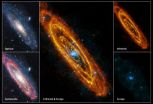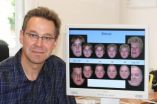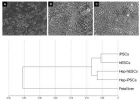(Press-News.org) Two ESA observatories have combined forces to show the Andromeda Galaxy in a new light. Herschel sees rings of star formation in this, the most detailed image of the Andromeda Galaxy ever taken at infrared wavelengths, and XMM-Newton shows dying stars shining X-rays into space.
During Christmas 2010, ESA's Herschel and XMM-Newton space observatories targeted the nearest large spiral galaxy M31. This is a galaxy similar to our own Milky Way – both contain several hundred billion stars. This is the most detailed far-infrared image of the Andromeda Galaxy ever taken and shows clearly that more stars are on their way.
Sensitive to far-infrared light, Herschel sees clouds of cool dust and gas where stars can form. Inside these clouds are many dusty cocoons containing forming stars, each star pulling itself together in a slow gravitational process that can last for hundreds of millions of years. Once a star reaches a high enough density, it will begin to shine at optical wavelengths. It will emerge from its birth cloud and become visible to ordinary telescopes.
Many galaxies are spiral in shape but Andromeda is interesting because it shows a large ring of dust about 75 000 light-years across encircling the centre of the galaxy. Some astronomers speculate that this dust ring may have been formed in a recent collision with another galaxy. This new Herschel image reveals yet more intricate details, with at least five concentric rings of star-forming dust visible.
Superimposed on the infrared image is an X-ray view taken almost simultaneously by ESA's XMM-Newton observatory. Whereas the infrared shows the beginnings of star formation, X-rays usually show the endpoints of stellar evolution.
XMM-Newton highlights hundreds of X-ray sources within Andromeda, many of them clustered around the centre, where the stars are naturally found to be more crowded together. Some of these are shockwaves and debris rolling through space from exploded stars, others are pairs of stars locked in a gravitational fight to the death.
In these deadly embraces, one star has already died and is pulling gas from its still-living companion. As the gas falls through space, it heats up and gives off X-rays. The living star will eventually be greatly depleted, having much of its mass torn from it by the stronger gravity of its denser partner. As the stellar corpse wraps itself in this stolen gas, it could explode.
Both the infrared and X-ray images show information that is impossible to collect from the ground because these wavelengths are absorbed by Earth's atmosphere. The twinkling starlight seen from Earth is indeed a beautiful sight but in reality contains less than half the story. Visible light shows us the adult stars, whereas infrared gives us the youngsters and X-rays show those in their death throes.
To chart the lives of stars, we need to see it all and that is where Herschel and XMM-Newton contribute so much.
INFORMATION:
Andromeda's once and future stars
2011-01-06
ELSE PRESS RELEASES FROM THIS DATE:
Maternal depression adversely affects quality of life in children with epilepsy
2011-01-06
A study by Canadian researchers examined the prevalence of maternal depression and its impact on children newly diagnosed with epilepsy. Prevalence of depression in mothers ranged from 30%-38% within the first 24 months following a child's epilepsy diagnosis. The mother's depressive symptoms negatively impacted the child's health-related quality of life, but the effects were moderated by the amount of family resources and mediated by how well the family functions and the extent of family demands. Details of this novel study appear online in Epilepsia, a journal published ...
How to look younger without plastic surgery
2011-01-06
How to look younger without plastic surgery? Psychologists of the Jena University (Germany) have a simple solution to this question: Those who want to look younger should surround themselves with older people. Because when viewing a 30-year-old we estimate his age to be much younger if we have previously been perceiving faces of older people.
"People are actually quite good at guessing the age of the person next to them," Dr. Holger Wiese says. The psychologist of the Jena University is responsible for one of six research projects in the DFG-sponsored research unit "Person ...
Hepatitis C: In 2011, a predictive marker for response to therapy
2011-01-06
Scientists at Inserm and Institut Pasteur have performed biomarker discovery on patients being treated for chronic hepatitis C infection. Their work, published in The Journal of Clinical Investigation, demonstrates that the plasma levels of the protein IP-10 predict, prior to treatment initiation, the efficacy of treatment with pegylated-interferon and ribavirin. Based on these results, the scientists have developed a prognostic test. Commercialization is anticipated in 2011, and will help inform physicians of the chances that patients will respond to standard treatment ...
Helicopter transport increases survival for seriously injured patients
2011-01-06
Severely injured patients transported by helicopter from the scene of an accident are more likely to survive than patients brought to trauma centers by ground ambulance, according to a new study published in The Journal of Trauma: Injury, Infection, and Critical Care. The study is the first to examine the role of helicopter transport on a national level and includes the largest number of helicopter-transport patients in a single analysis.
The finding that helicopter transport positively impacts patient survival comes amid an ongoing debate surrounding the role of helicopter ...
Is the hornet our key to renewable energy?
2011-01-06
As every middle-school child knows, in the process of photosynthesis, plants take the sun's energy and convert it to electrical energy. Now a Tel Aviv University team has demonstrated how a member of the animal kingdom, the Oriental hornet, takes the sun's energy and converts it into electric power -- in the brown and yellow parts of its body -- as well.
"The interesting thing here is that a living biological creature does a thing like that," says physicist Prof. David Bergman of Tel Aviv University's School of Physics and Astronomy, who was part of the team that made ...
Exercise may lower risk of death for men with prostate cancer
2011-01-06
Boston, MA – A new study of men with prostate cancer finds that physical activity is associated with a lower risk of overall mortality and of death due to prostate cancer. The Harvard School of Public Health and University of California, San Francisco researchers also found that men who did more vigorous activity had the lowest risk of dying from the disease. It is the first study in men with prostate cancer to evaluate physical activity after diagnosis in relation to prostate cancer-specific mortality and overall mortality.
The study appears in an advance online edition ...
Where MRSA colonizes on the human body
2011-01-06
PROVIDENCE, RI – When methicillin-resistant S. aureus (MRSA) is carried in the nose (nares), it is a risk factor for an invasive infection, including a surgical site infection. Some studies have found that the heavier the carriage of MRSA in the nose, the greater the risk of transmission to others and the greater risk of infection to the patient. Few studies to date have assessed the differences in quantity of MRSA at different body sites. A new study from Rhode Island Hospital now sheds light on both the quantity of MRSA at different body sites and the relationship between ...
Thermostatic mixer valves could significantly reduce the risk of scalding in children, study finds
2011-01-06
Using a thermostatic mixer valve to control the maximum temperature of children's bath water can significantly reduce the temperature of hot bath water and should reduce the risk of scalding, according to researchers at The University of Nottingham.
The study, carried out in partnership with Glasgow Housing Association, found that families with a thermostatic mixing valve (TMV) fitted to the hot and cold water pipes in their bathroom had bath water temperatures that were up to 11˚C cooler than those without and their baths were within the recommended temperature ...
Different sources, same result
2011-01-06
Numerous patients suffering from chronic liver diseases are currently receiving inadequate treatment due to the lack of organs donated for transplantation. However, hepatocytes derived from induced pluripotent stem cells (iPSCs) could offer an alternative for the future. Scientists from the Max Planck Institute for Molecular Genetics in Berlin compared hepatocytes from embryonic stem cells with hepatocytes from iPS cells and found that their gene expression is very similar. Nevertheless, in comparison to "real" hepatocytes, just under half of the genes exhibited a different ...
Protective properties of green tea uncovered
2011-01-06
Regularly drinking green tea could protect the brain against developing Alzheimer's and other forms of dementia, according to latest research by scientists at Newcastle University.
The study, published in the academic journal Phytomedicine, also suggests this ancient Chinese remedy could play a vital role in protecting the body against cancer.
Led by Dr Ed Okello, the Newcastle team wanted to know if the protective properties of green tea – which have previously been shown to be present in the undigested, freshly brewed form of the drink – were still active once the tea ...


